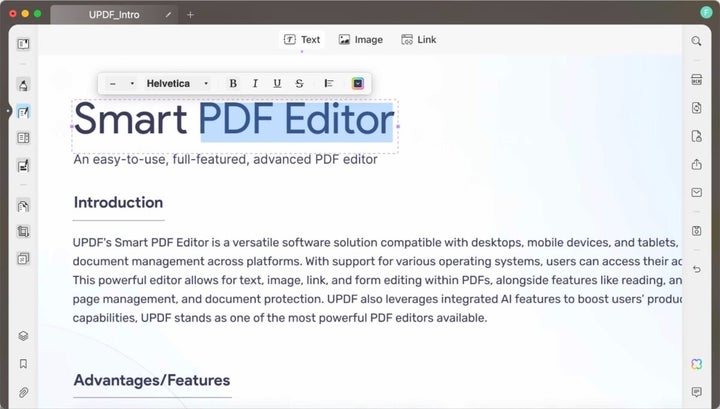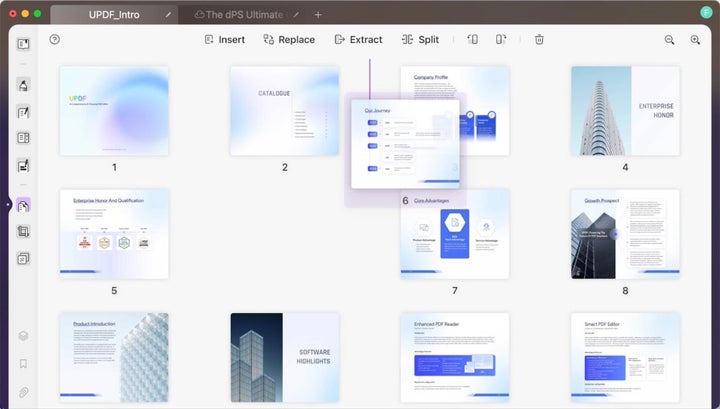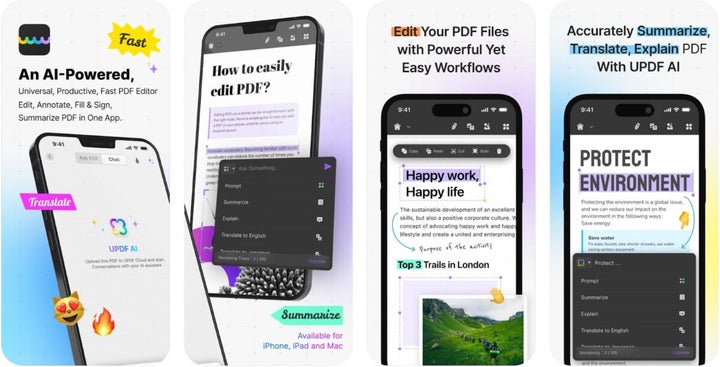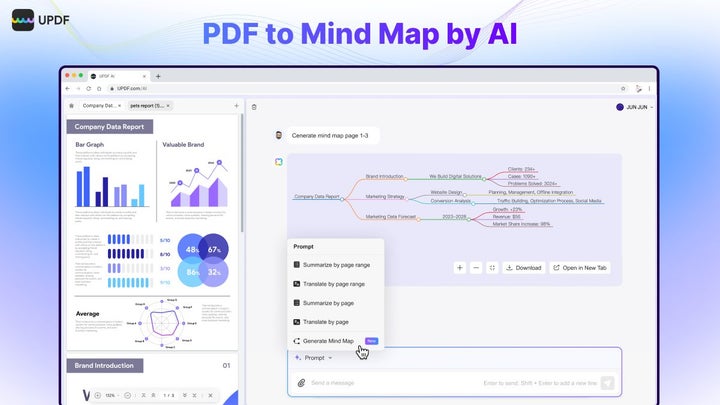Managing and editing PDF documents has become essential for professionals and everyday users. Despite the necessity, editing PDFs has traditionally been challenging due to limited functionality or overly complex tools. This is where UPDF distinguishes itself as an exceptional PDF editor, suitable for any platform. With its user-friendly interface and advanced features presented simply, UPDF enables efficient PDF editing, providing a seamless experience on Windows, Mac, iOS, and Android. Don't miss out on UPDF's Black Friday Sale, available for Softonic users!
Editing PDFs on Windows or Mac with UPDF
UPDF excels at editing PDFs on both Windows and Mac, offering comprehensive capabilities. You can edit text, images, and links, or even reorganize and manage entire pages—all from a single platform.
Editing Text in a PDF
UPDF makes text editing in PDFs straightforward and efficient. Whether you need to delete, modify, or add text, it handles everything while preserving the original format of the document.
To change or delete text in a PDF, simply click on the “Edit PDF” icon in the left sidebar to activate editing mode. In this mode, select the text you wish to modify or remove. Clicking on it will highlight it with a purple border. To delete text, position the cursor at the end and press the delete key, or replace it by typing a new word or phrase directly.
data-ad-slot="5894222211"
data-ad-format="auto"
data-full-width-responsive="true">
Beyond modifying and deleting text, UPDF also allows you to adjust text styles using the upper toolbar, where you can alter font type, size, color, and alignment.
We can also add text as part of a document, which we do by clicking on the “Edit PDF” icon on the sidebar and selecting the “Text” icon on the upper bar. Clicking anywhere on the document, we can begin typing. As before, we can customize the style of the added text, including font, size, color, and alignment. To exit editing mode, we click outside the text box.
If we want to add text as a comment, we simply click on the “Comment” icon on the sidebar and select “Text Comment”.
How to Edit Images in a PDF
UPDF also allows us to edit and add images in PDF documents quickly and easily. To edit an image, we enter editing mode and select the image of interest; we can rotate, extract, crop, replace, or delete it. Additionally, we can adjust its size by dragging the corners or specifying exact dimensions.
We can also add new images by clicking on “Edit PDF” and selecting the “Image” icon to insert one from our device.
How to Edit Links in a PDF
UPDF makes adding, editing, and deleting links in PDF documents extremely easy, which is ideal for connecting and expanding information interactively.
To add a link, we simply click on the “Edit PDF” tab and select “Link” on the top bar. Then, we click anywhere in the PDF to insert a link. We can choose from “Web Link” to add a URL or “Page Link” to link a page within the same PDF.
If we want to edit a link, we simply select it in the PDF and access “Properties” to modify the link type, line style, thickness, and color of the border. Finally, if we want to remove it, we right-click on it and select “Delete” to remove it from the document.
How to Manage PDF Pages: Crop, Delete, Rotate, and Split
UPDF offers a wide variety of tools to organize PDF pages, which makes presenting documents professionally easier.
To insert pages, we can do it in several ways: add a blank page, from another PDF file, or even from the clipboard. We also have the option to add images as pages directly in the document. If we need to replace a page, we select the desired page and choose the PDF file with which we want to replace it.
If we want to extract pages, we simply select them and save them in a new file; we can even delete them from the original document after extraction. If we want to split the PDF, we can do it by the number of pages, file size, top-level bookmarks, or custom elements, depending on what best suits our goal.
To adjust the layout, we select the pages and use the rotation options clockwise or counterclockwise as needed. If we find pages we no longer need, we easily delete them by selecting them and using the delete option. Additionally, in organization mode, we can zoom in on page thumbnails, which is very useful when working with documents that have small text and we need a more detailed view.
With UPDF, we can also crop pages in a PDF. To do this, we select the “Crop Pages” option, adjust the cropping area with the purple box, and apply the change with the “Crop” button. On the right panel, we can configure margins, cropped page size, and restrict proportions as needed.
If we want to apply cropping to multiple pages, we use “Apply Changes” to define a specific range, and we can even crop only odd or even pages. Additionally, UPDF allows us to split a page with horizontal or vertical division lines, also selecting the reading direction, and, when applying the “Split” option, we can delete the original page after splitting it.
How to Edit a PDF on Our iPhone or Android with UPDF
One of the biggest advantages of UPDF is its ability to edit PDF files on the go from mobile devices. An essential resource when we need quick and versatile access to documents, no matter where we are. Whether from an iPhone, iPad, or Android device, UPDF for iOS and Android allows us to make modifications to text, images, and links at any time.
In the mobile version of UPDF, editing text in a PDF is as simple as doing it on the desktop. We just need to select the text area we want to modify, and we can make changes to the content.
The mobile app also allows us to add or adjust images within the PDF. We can insert a new image (perhaps just captured with the camera), change its size, or move its position with simple gestures.
Another key function in the mobile version of UPDF is the ability to add links to web pages or other parts of the document. This makes creating interactive and navigable PDFs easy, even from a mobile device.
Where other editors are not present, on our mobile devices, UPDF stands out. With a very universal interface, yet always adapted to the nature of each device from which we work, any management is simple, quick, and efficient. Of course, edits made on a mobile device are maintained when opening the document on the computer, ensuring a smooth and efficient workflow that we can pick up and continue wherever we are.
Much More Than a PDF Editor: AI, Annotations, and OCR, Among Others
In addition to its text editing, image, and link tools, UPDF offers several options that go far beyond what we usually find in a PDF editor.
The AI function in UPDF allows us, for example, to perform complex tasks automatically, such as summarizing pages, simplifying graphics, making translations, or, chat with AI. Very importantly, UPDF AI has the capability to convert PDFs into mind maps, allowing you to quickly grasp the outline and main ideas of lengthy documents. . This technology optimizes our workflow in a unique way, making managing large amounts of data or complex information faster and more efficient than ever.
The OCR functionality of UPDF turns scanned documents or images into editable text, completely changing how we digitize printed documents. OCR recognition is essential for archiving and organizing physical documents in digital format.
Another point is that UPDF greatly facilitates the ability to add comments, underlines, highlights, and notes to the PDF document. This is ideal for text review and team collaboration. The annotation tool allows us to make precise and detailed comments that can be saved and shared easily.
UPDF also allows us to convert PDF files to various formats, such as Word, Excel, PowerPoint, and others, without losing quality or, very importantly, format. To conclude, it is worth highlighting UPDF’s digital signature and form tool, which makes filling out and signing documents quick and secure.





